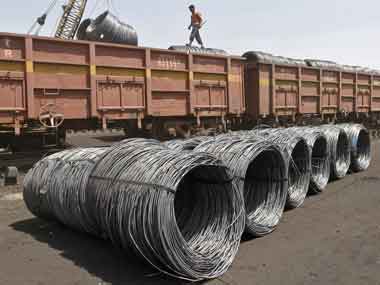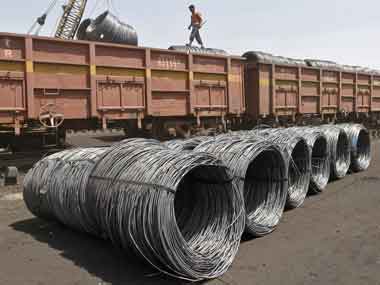Ambitious expansion plans cast against a frail financial condition have been the real talking point of the first railway budget presented by the Narendra Modi government. The question whether this budget is actually implementable on the ground is not unfounded given the whopping expenditure the railways bear only to sustain itself somehow. Just to cite an example, the Ministry of Railways in a release said, “Out of total expenditure, the ordinary working expenses have been proposed at Rs. 1,12,649 crore, which is Rs. 15,078 crore higher than 2013-14. This has been necessitated by fuel price hike and increase in staff costs. Pension outgo in 2013-14 had grown by about 16%. Keeping the same trend, provision for pension is kept at Rs. 28,850 crore.” [caption id=“attachment_1609361” align=“alignleft” width=“380”]
 Can railways generate more money? Reuters[/caption] However, the markets were equally not favourable to the railway budget as the Sensex fell by over 500 points while the Nifty tanked by over 160 points.
Reuters reported
that the market sentiment was negative because the budget numbers were lower than what the indices were expecting. " Analysts also said the plan in the railway budget to seek private funding for new projects did not provide enough details on how it would attract investors,"
the report said
. “The number of things that they have promised were already there in the UPA scheme of things like wi-fi in trains and stations. The government has put up a huge expansion plan. But is it not prudent to take care of safety and security instead of introducing a bullet train between two short distance places like Mumbai and Ahmedabad? My biggest worry is the lopsided priority of the government,” Congress spokesperson Sanjay Jha told CNN-IBN during a panel discussion. The estimated cost of a bullet train between Mumbai and Ahmedabad is pegged at a massive Rs 60,000 crore while the Railway Minister Sadananda Gowda in his budget speech in Parliament on Tuesday said that “over Rs. 40,000 crore would be needed to be invested in track renewals, elimination of unmanned level crossing and construction of Road-under-bridges and Road-over-bridges”. Doubts were also expressed if the method of fund raising for the railways through FDI and PPP may not work at all. However, the Centre felt that the railways will interact with industry and take further steps to attract investment under PPP through BOT and annuity route and also identify eight to 10 capacity augmentation projects on congested routes. Founding CMD, Concor, Raghu Dayal felt that the existing PPP has failed to attract any investors. “There are several contradictions in the budget although there is good diagnosis. The PPP is in itself a non-starter for the last 7-8 years. There are no takers for it. It has got some intrinsic issues. The railways are not able to sustain themselves,” he said. But Dayal presented some silver lining. “There is a tremendous amount of scope for cutting cost. Nearly half a million people can be shed in course of time to cut cost,” Dayal said. Earlier in the day former railway minister Lalu Prasad criticised the PPP mode saying, “I strongly fear that railway budget has made a move in the direction to privatise itself at the cost of the interests of the people.” Jha also raised similar doubts saying the “monopoly public unit will be handed over to crony capitalists in bits and pieces”. “The British experiment in privatising the railways has not been successful. The consumers over there eventually paid a lot. It is easy to make grandiose announcements but PPP and FDI suggest that the government is predicating the future of the railways,” he said. Former member, Railway traffic, CM Khosla said that raising money through higher fares is very limited. “The scope for increase in fare and freight rates is very limited. The railways will need strong budgetary support,” he said. In the face of such stringent criticism, BJP spokesperson Sambit Patra, was left to defend the railway budget. “This railway budget is a budget of implementation and execution. The Congress in the last 10 years used railways as an appeasement tool. We do not have any restrictions of areas and pockets. The Congress promised but never delivered. There was a great deal of red-tapism and policy paralysis in the last government. We want to make the railway earnings in freight to be one percent of the country’s GDP. The railways can actually influence the GDP,” Patra said.
Can railways generate more money? Reuters[/caption] However, the markets were equally not favourable to the railway budget as the Sensex fell by over 500 points while the Nifty tanked by over 160 points.
Reuters reported
that the market sentiment was negative because the budget numbers were lower than what the indices were expecting. " Analysts also said the plan in the railway budget to seek private funding for new projects did not provide enough details on how it would attract investors,"
the report said
. “The number of things that they have promised were already there in the UPA scheme of things like wi-fi in trains and stations. The government has put up a huge expansion plan. But is it not prudent to take care of safety and security instead of introducing a bullet train between two short distance places like Mumbai and Ahmedabad? My biggest worry is the lopsided priority of the government,” Congress spokesperson Sanjay Jha told CNN-IBN during a panel discussion. The estimated cost of a bullet train between Mumbai and Ahmedabad is pegged at a massive Rs 60,000 crore while the Railway Minister Sadananda Gowda in his budget speech in Parliament on Tuesday said that “over Rs. 40,000 crore would be needed to be invested in track renewals, elimination of unmanned level crossing and construction of Road-under-bridges and Road-over-bridges”. Doubts were also expressed if the method of fund raising for the railways through FDI and PPP may not work at all. However, the Centre felt that the railways will interact with industry and take further steps to attract investment under PPP through BOT and annuity route and also identify eight to 10 capacity augmentation projects on congested routes. Founding CMD, Concor, Raghu Dayal felt that the existing PPP has failed to attract any investors. “There are several contradictions in the budget although there is good diagnosis. The PPP is in itself a non-starter for the last 7-8 years. There are no takers for it. It has got some intrinsic issues. The railways are not able to sustain themselves,” he said. But Dayal presented some silver lining. “There is a tremendous amount of scope for cutting cost. Nearly half a million people can be shed in course of time to cut cost,” Dayal said. Earlier in the day former railway minister Lalu Prasad criticised the PPP mode saying, “I strongly fear that railway budget has made a move in the direction to privatise itself at the cost of the interests of the people.” Jha also raised similar doubts saying the “monopoly public unit will be handed over to crony capitalists in bits and pieces”. “The British experiment in privatising the railways has not been successful. The consumers over there eventually paid a lot. It is easy to make grandiose announcements but PPP and FDI suggest that the government is predicating the future of the railways,” he said. Former member, Railway traffic, CM Khosla said that raising money through higher fares is very limited. “The scope for increase in fare and freight rates is very limited. The railways will need strong budgetary support,” he said. In the face of such stringent criticism, BJP spokesperson Sambit Patra, was left to defend the railway budget. “This railway budget is a budget of implementation and execution. The Congress in the last 10 years used railways as an appeasement tool. We do not have any restrictions of areas and pockets. The Congress promised but never delivered. There was a great deal of red-tapism and policy paralysis in the last government. We want to make the railway earnings in freight to be one percent of the country’s GDP. The railways can actually influence the GDP,” Patra said.
Promises, promises: Can Modi sarkaar deliver on railway budget?
FP Staff
• July 9, 2014, 08:54:46 IST
Doubts were also expressed if the method of fund raising for the railways through FDI and PPP may not work at all.
Advertisement
)
End of Article